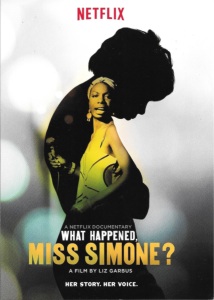 The opening moments of the Oscar nominated Netflix documentary “What Happened, Miss Simone?” are so volatile and unpredictable in a way that captured Nina Simone’s musical essence, and it’s a shame director Liz Garbus can’t harness that lightning in a bottle throughout the rest of her film. It becomes a far more conventional musical biography told in relative chronological order, but is still entertaining and revealing about this influential musician’s life.
The opening moments of the Oscar nominated Netflix documentary “What Happened, Miss Simone?” are so volatile and unpredictable in a way that captured Nina Simone’s musical essence, and it’s a shame director Liz Garbus can’t harness that lightning in a bottle throughout the rest of her film. It becomes a far more conventional musical biography told in relative chronological order, but is still entertaining and revealing about this influential musician’s life.
Simone saunters on stage at a concert in Switzerland. We’ll learn later in the film that this was her first show after a long hiatus, when she feared that few would still know her name. She does a big, long bow, sits at the piano and looks far off into the distance of the crowd. Her facial features are worn, very black, with big teeth and not the most flattering of looks later in her age, but she has a natural quality and magnetic allure.
This one performance interlude opening the film shows everything about how Simone battled issues of her appearance, of her skin color, and of her identity on stage throughout her entire career. In it she announces that she would play no more jazz festivals, and there’s a sense for why Simone, who passed away in 2003, had vanished from the cultural sphere and is now re-emerging. Her music can reach a new generation of listeners with its racially and politically charged lyrics (boycotted by some in the ‘60s and ‘70s) and sound tied directly to her time and upbringing.
Garbus’s film takes us through the beginning of Simone’s life, born Eunice Waymon, up through some of her final performances. When her daughter appears on camera in present day and gives her talking head interview after such an arresting open, it’s almost immediately something of a let down. But she says, “She was Nina Simone 24/7, and that was the start of the problem.”
Garbus finds some choice clips of Simone performing alongside Hugh Hefner on “Playboy’s Penthouse” and of how she came to record the vital and controversial song “Mississippi Goddamn.” These clips allow those interviewed to argue that the reason Simone doesn’t fall into the revered company of Aretha Franklin and Gladys Knight today was specifically because of her politics and how she was literally and figuratively blacker than the rest.
But “What Happened, Miss Simone?” goes beyond that easy assessment of fame, examining how she then became stifled in her identity once off stage. Her daughter describes her as monstrous, taunting and violent in middle age. “I think I would’ve been happier as the first black classical pianist. I am not very happy now,” Simone says bluntly. These are gripping stories of personal demons that, like this year’s “Amy,” do more than just celebrate the artist at hand.
Garbus however perhaps gets inside Simone’s music with more success compared to “Amy.” “Mississippi Goddamn,” the film points out, is such a bouncy song, an angry screed against her home state with a pop, jazzy sensibility. That song gets countered with the bone chilling “Strange Fruit,” such a strong example of how Simone’s music “exposed the sickness” of the American South in the ‘60s.
“What Happened, Miss Simone?” however begs for the visual creativity of 2015’s “Kurt Cobain: Montage of Heck” or the attention to detail in the archival editing room of “Amy.” The film can’t help but feel weighed down slightly by its own storytelling convention. Only in the film’s opening moments when Simone is mysterious and odd on stage can we feel her vitality.
3 stars